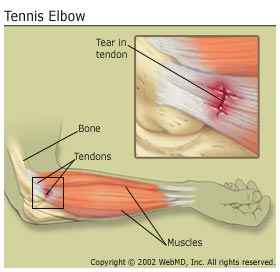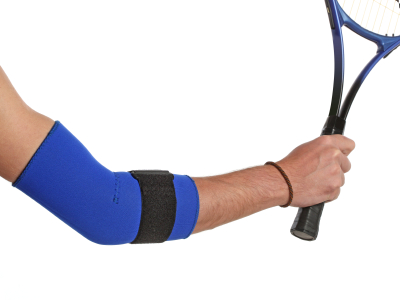Rather, it is a series of possible solutions to help alleviate the pain while giving time for the tennis elbow to heal. It’s a terrible moment, isn’t it?
The first time you feel that twinge in your elbow and remember the common term for it: “tennis elbow.” That would make sense. Your elbow hurts and you are in the midst of a match.
Yep, you’ve got tennis elbow. Now what?
The good piece of news about tennis elbow is that most of the treatments are quite successful and 95% of those players affected by it recover without surgery. The bad news is that rest is a central part of any sound treatment for tennis elbow.
You might need to stay off the court for weeks or even months, depending on how many small tears there are in your tendon.
Let’s explore more deeply some common tennis elbow tips:
Tennis Elbow Tip #1:
The first tip is that tennis elbow should never be ignored. Your body is trying to tell you something, namely, that you have injured the tendon in your elbow that is used all of the time while you play the sport. The first home treatment should be rest. This might be all that you need.
Tennis Elbow Tip #2:


Second, you can take a more proactive approach to your pain by seeking to reduce it. This can be done through ice or cold packs for 10-15 minutes at a time, several times a day. Be sure to put at least a thin cloth between the ice you use and your skin. Hot baths can also help with this pain. Experiment a bit with hot and cold treatments and see what works best for you.
Tennis Elbow Tip #3:
If ice and hot baths are not reducing the pain as much as you would like, take an anti-inflammatory drug, such as aspirin, ibuprofen or naproxen (such as Aleve). You can also find anti-inflammatory drugs in cream form to rub over the sore area.
Tennis Elbow Tip #4:
If you are doing certain movements at home or work that make the elbow hurt, try to change the activities or the motions associated with them. You might need your spouse or a friend to do certain activities for you as your tendon heals. You do not want to re-aggravate tennis elbow while raking leaves, for instance, if that causes you pain. Any activities that involve the use of your forearms might have to go undone for awhile.
If the pain persists despite rest and drug treatment, you might need a splint for a time. These are easily obtainable at any pharmacy. They don’t work for everyone with tennis elbow, but they might be worth a try on a temporary basis.
Tennis Elbow Tip #5:
As you think about returning to the court, you should plan on spending a bit of time doing rehab exercises to strengthen the muscles around the tendon and minimize the chances of re-injuring it. You can do warm-up exercises for tennis elbow, as well as stretching movements that will prepare the joint for strengthening exercises. If your tennis elbow is so bad that you need such rehab, talk to your doctor about a wise plan. Exercises are available all over the Web, but you need to be careful that you are not attempting to strengthen a tendon when it is not even healed yet. If your tennis elbow persists despite rest and ice treatment, it is time to talk to a doctor about it.
Tennis Elbow Tips and Solutions
Your doctor could quite possibly prescribe a handy counterforce brace, which has come into vogue in recent years. This strap is worn around the forearm just below the elbow and spreads pressure throughout the arm rather than having all of the strain concentrated on the tendon in your elbow.
There are exercises that accompany the wearing of such a brace, and you don’t have to wait to see a doctor to get one. They are available in most pharmacies and sporting goods stores without a prescription. Some players solve their tennis elbow by using such braces.
Tennis Elbow Tip – You May Need to Fix Your Technique!
In addition to your doctor, you might want to consult a trainer or tennis coach to find out if you need to change a motion or your equipment while playing tennis to eliminate tennis elbow. Sometimes tennis players need specialized insight as to how to treat this common injury. You might have a hitch in your stroke that is putting too much strain on your elbow. Better form is sometimes the cure for tennis elbow, after a period of rest.
If you are like many players, you will try to get back on the court before you should, thus re-aggravating the injury. This is not a wise move at all, even though it is common. The reason is it can cause severe tendon damage that could lead to surgery. Your doctor will try several approaches before recommending that you go under the knife.
Among some tennis elbow tips and therapy will be:
a) corticosteroid injections, which relieve pain for a short time. If you have pain after 6-8 weeks of rest and rehab, such injections might be needed;
b) ultrasound therapy, which in some cases heals the tendon, thus taking away the pain as well.
If all else fails, you will probably need surgery. Again, fewer than 5 out of 100 players with tennis elbow need surgery, but you could be one of those 5. If the elbow does not improve after 6-12 months of rest and rehab, then surgery might be necessary. What the surgeon will do is cut the tendon, remove damaged tissue from it and then repair the tendon, perhaps with tissue from another part of the body.
Tennis Elbow Tips for Dealing With the Injury in Real Life


This column on tennis elbow tips would be incomplete without a broader perspective to help you choose what treatment plan is right for you. Here are some questions to answer as you do a bit of self-diagnosis:
-Does the elbow pain affect your job or daily life?
-Are you willing or able to change your habits or activities that seem to cause elbow pain?
-Do you think the pain that you have is simply a result of overuse?
-Did tennis elbow come on gradually or suddenly?
-All of these questions can assist you as you ponder how to proceed with tennis elbow. If the pain persists and is affecting your daily life, you probably need to see a doctor. If you are willing to change the activities that cause your elbow pain (outside of tennis), then rest and rehab might work more efficiently for you.
Tennis Elbow Tip- Perhaps Consider Giving Your Injury Some Rest
If you think the pain is simply a result of overuse, you need to cut back on your playing schedule after a time of rest and rehab. If your tennis elbow came on gradually, then the tears in your tendon might be problematic and need extra rest. If the elbow does not respond to rest and rehab, you should see a doctor. A sudden case of tennis elbow could indicate a large tear in the tendon that might require surgery.
Again, fortunately, most cases of tennis elbow respond quite well to rest, ice, rehab exercises, pain medicine and/or counterforce braces. Even as you follow these tennis elbow tips, it might take you 6-12 months to relieve your symptoms and ensure healing of the tendon. Sorry about that! I wish that you could get back on the court sooner, but you might have to skip next year’s round of club and city tournaments.
Another Tennis Elbow Tip- Do Not Get Too Disappointed
You’ll come back stronger than ever and more equipped to snatch the crown once you follow these tennis elbow tips and your joint is rested, healed and back to 100%. After rehab exercises, and with your new brace, your elbow might be at 100+% capacity. Then, your opponents will have that much more to worry about! Tennis elbow does not mean that you have to give up the sport. It does mean that you will need to sit on the sidelines for awhile.
Learn to Hit a Forehand Like Roger Federer
If you want to jumpstart your forehand and play like the PROS, check out my 70+ page Tennis Ebook that will immediately show you how you can take your forehand to the next level.
The Modern Forehand Domination Ebook is guaranteed to improve your tennis technique, and increase power, topspin and accuracy of your tennis forehand!
Modern Tennis Forehand Ebook
Learn How to Hit a Forehand Like Federer, Nadal and Djokovic

